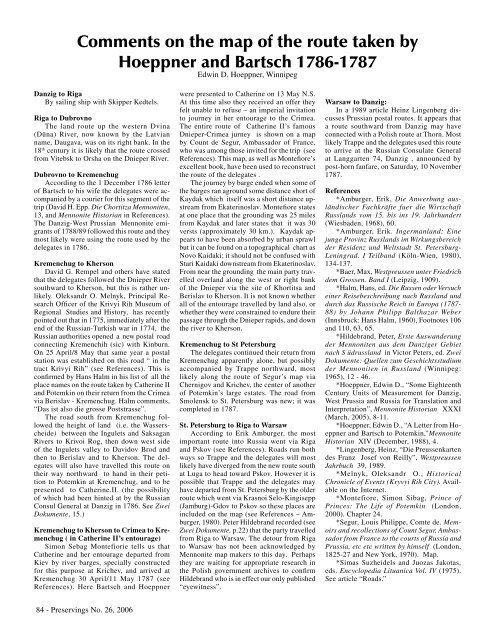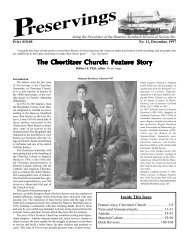Preservings $20 Issue No. 26, 2006 - Home at Plett Foundation
Preservings $20 Issue No. 26, 2006 - Home at Plett Foundation
Preservings $20 Issue No. 26, 2006 - Home at Plett Foundation
You also want an ePaper? Increase the reach of your titles
YUMPU automatically turns print PDFs into web optimized ePapers that Google loves.
Comments on the map of the route taken by<br />
Hoeppner and Bartsch 1786-1787<br />
Edwin D. Hoeppner, Winnipeg<br />
Danzig to Riga<br />
By sailing ship with Skipper Kedtels.<br />
Riga to Dubrovno<br />
The land route up the western Dvina<br />
(Düna) River, now known by the L<strong>at</strong>vian<br />
name, Daugava, was on its right bank. In the<br />
18 th century it is likely th<strong>at</strong> the route crossed<br />
from Vitebsk to Orsha on the Dnieper River.<br />
Dubrovno to Kremenchug<br />
According to the 1 December 1786 letter<br />
of Bartsch to his wife the deleg<strong>at</strong>es were accompanied<br />
by a courier for this segment of the<br />
trip (David H. Epp. Die Chortitza Mennoniten,<br />
13, and Mennonite Historian in References).<br />
The Danzig-West Prussian Mennonite emigrants<br />
of 1788/89 followed this route and they<br />
most likely were using the route used by the<br />
deleg<strong>at</strong>es in 1786.<br />
Kremenchug to Kherson<br />
David G. Rempel and others have st<strong>at</strong>ed<br />
th<strong>at</strong> the deleg<strong>at</strong>es followed the Dnieper River<br />
southward to Kherson, but this is r<strong>at</strong>her unlikely.<br />
Oleksandr O. Melnyk, Principal Research<br />
Officer of the Krivyi Rih Museum of<br />
Regional Studies and History, has recently<br />
pointed out th<strong>at</strong> in 1775, immedi<strong>at</strong>ely after the<br />
end of the Russian-Turkish war in 1774, the<br />
Russian authorities opened a new postal road<br />
connecting Kremenchih (sic) with Kinburn.<br />
On 25 April/8 May th<strong>at</strong> same year a postal<br />
st<strong>at</strong>ion was established on this road “ in the<br />
tract Krivyi Rih” (see References). This is<br />
confirmed by Hans Halm in his list of all the<br />
place names on the route taken by C<strong>at</strong>herine II<br />
and Potemkin on their return from the Crimea<br />
via Berislav - Kremenchug. Halm comments,<br />
“Das ist also die grosse Poststrasse”.<br />
The road south from Kremenchug followed<br />
the height of land (i.e. the Wasserscheide)<br />
between the Ingulets and Saksagan<br />
Rivers to Krivoi Rog, then down west side<br />
of the Ingulets valley to Davidov Brod and<br />
then to Berislav and to Kherson. The deleg<strong>at</strong>es<br />
will also have travelled this route on<br />
their way northward to hand in their petition<br />
to Potemkin <strong>at</strong> Kremenchug, and to be<br />
presented to C<strong>at</strong>herine.II. (the possibility<br />
of which had been hinted <strong>at</strong> by the Russian<br />
Consul General <strong>at</strong> Danzig in 1786. See Zwei<br />
Dokumente, 15.)<br />
Kremenchug to Kherson to Crimea to Kremenchug<br />
( in C<strong>at</strong>herine II’s entourage)<br />
Simon Sebag Montefiorie tells us th<strong>at</strong><br />
C<strong>at</strong>herine and her entourage departed from<br />
Kiev by river barges, specially constructed<br />
for this purpose <strong>at</strong> Krichev, and arrived <strong>at</strong><br />
Kremenchug 30 April/11 May 1787 (see<br />
References). Here Bartsch and Hoeppner<br />
were presented to C<strong>at</strong>herine on 13 May N.S.<br />
At this time also they received an offer they<br />
felt unable to refuse – an imperial invit<strong>at</strong>ion<br />
to journey in her entourage to the Crimea.<br />
The entire route of C<strong>at</strong>herine II’s famous<br />
Dnieper-Crimea jurney is shown on a map<br />
by Count de Segur, Ambassador of France,<br />
who was among those invited for the trip (see<br />
References). This map, as well as Montefiore’s<br />
excellent book, have been used to reconstruct<br />
the route of the deleg<strong>at</strong>es .<br />
The journey by barge ended when some of<br />
the barges ran aground some distance short of<br />
Kaydak which itself was a short distance upstream<br />
from Ek<strong>at</strong>erinoslav. Montefiore st<strong>at</strong>es<br />
<strong>at</strong> one place th<strong>at</strong> the grounding was 25 miles<br />
from Kaydak and l<strong>at</strong>er st<strong>at</strong>es th<strong>at</strong> it was 30<br />
versts (approxim<strong>at</strong>ely 30 km.). Kaydak appears<br />
to have been absorbed by urban sprawl<br />
but it can be found on a topographical chart as<br />
<strong>No</strong>vo Kaidaki; it should not be confused with<br />
Stari Kaidaki downstream from Ek<strong>at</strong>erinoslav.<br />
From near the grounding the main party travelled<br />
overland along the west or right bank<br />
of the Dnieper via the site of Khortitsa and<br />
Berislav to Kherson. It is not known whether<br />
all of the entourage travelled by land also, or<br />
whether they were constrained to endure their<br />
passage through the Dnieper rapids, and down<br />
the river to Kherson.<br />
Kremenchug to St Petersburg<br />
The deleg<strong>at</strong>es continued their return from<br />
Kremenchug apparently alone, but possibly<br />
accompanied by Trappe northward, most<br />
likely along the route of Segur’s map via<br />
Chernigov and Krichev, the center of another<br />
of Potemkin’s large est<strong>at</strong>es. The road from<br />
Smolensk to St. Petersburg was new; it was<br />
completed in 1787.<br />
St. Petersburg to Riga to Warsaw<br />
According to Erik Amburger, the most<br />
important route into Russia went via Riga<br />
and Pskov (see References). Roads run both<br />
ways so Trappe and the deleg<strong>at</strong>es will most<br />
likely have diverged from the new route south<br />
<strong>at</strong> Luga to head toward Pskov. However it is<br />
possible th<strong>at</strong> Trappe and the deleg<strong>at</strong>es may<br />
have departed from St. Petersburg by the older<br />
route which went via Krasnoi Selo-Kingisepp<br />
(Jamburg)-Gdov to Pskov so these places are<br />
included on the map (see References – Amburger,<br />
1980). Peter Hildebrand recorded (see<br />
Zwei Dokumente, p.22) th<strong>at</strong> the party travelled<br />
from Riga to Warsaw. The detour from Riga<br />
to Warsaw has not been acknowledged by<br />
Mennonite map makers to this day. Perhaps<br />
they are waiting for appropri<strong>at</strong>e research in<br />
the Polish government archives to confirm<br />
Hildebrand who is in effect our only published<br />
“eyewitness”.<br />
Warsaw to Danzig:<br />
In a 1989 article Heinz Lingenberg discusses<br />
Prussian postal routes. It appears th<strong>at</strong><br />
a route southward from Danzig may have<br />
connected with a Polish route <strong>at</strong> Thorn. Most<br />
likely Trappe and the deleg<strong>at</strong>es used this route<br />
to arrive <strong>at</strong> the Russian Consul<strong>at</strong>e General<br />
<strong>at</strong> Langgarten 74, Danzig , announced by<br />
post-horn fanfare, on S<strong>at</strong>urday, 10 <strong>No</strong>vember<br />
1787.<br />
References<br />
*Amburger, Erik, Die Anwerbung ausländischer<br />
Fachkräfte fuer die Wirtschaft<br />
Russlands vom 15. bis ins 19. Jahrhundert<br />
(Wiesbaden, 1968), 60.<br />
*Amburger, Erik. Ingermanland: Eine<br />
junge Provinz Russlands im Wirkungsbereich<br />
der Residenz und Weltstadt St. Petersburg-<br />
Leningrad. I Teilband (Köln-Wien, 1980),<br />
134-137.<br />
*Baer, Max, Westpreussen unter Friedrich<br />
dem Grossen. Band I (Leipzig, 1909).<br />
*Halm, Hans, ed. Die Russen oder Versuch<br />
einer Reisebeschreibung nach Russland und<br />
durch das Russische Reich in Europa (1787-<br />
88) by Johann Philipp Balthazar Weber<br />
(Innsbruck: Hans Halm, 1960), Footnotes 106<br />
and 110, 63, 65.<br />
*Hildebrand, Peter, Erste Auswanderung<br />
der Mennoniten aus dem Danziger Gebiet<br />
nach S üdrussland in Victor Peters, ed. Zwei<br />
Dokumente: Quellen zum Geschichtsstudium<br />
der Mennoniten in Russland (Winnipeg:<br />
1965), 12 - 46.<br />
*Hoeppner, Edwin D., “Some Eighteenth<br />
Century Units of Measurement for Danzig,<br />
West Prussia and Russia for Transl<strong>at</strong>ion and<br />
Interpret<strong>at</strong>ion”, Mennonite Historian XXXI<br />
(March, 2005), 8-11.<br />
*Hoeppner, Edwin D., “A Letter from Hoeppner<br />
and Bartsch to Potemkin,”Mennonite<br />
Historian XIV (December, 1988), 4.<br />
*Lingenberg, Heinz, “Die Preussenkarten<br />
des Franz Josef von Reilly”, Westpreussen<br />
Jahrbuch 39, 1989.<br />
*Melnyk, Oleksandr O., Historical<br />
Chronicle of Events (Kryvyi Rih City). Available<br />
on the Internet.<br />
*Montefiore, Simon Sibag, Prince of<br />
Princes: The Life of Potemkin (London,<br />
2000). Chapter 24.<br />
*Segur, Louis Philippe, Comte de. Memoirs<br />
and recollections of Count Segur, Ambassador<br />
from France to the courts of Russia and<br />
Prussia, etc etc written by himself (London,<br />
1825-27 and New York, 1970). Map.<br />
*Simas Suzheidels and Juozas Jakotas,<br />
eds. Encyclopedia Lituanica Vol. IV (1975).<br />
See article “Roads.”<br />
84 - <strong>Preservings</strong> <strong>No</strong>. <strong>26</strong>, <strong>2006</strong>
















